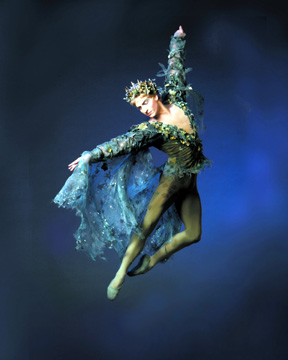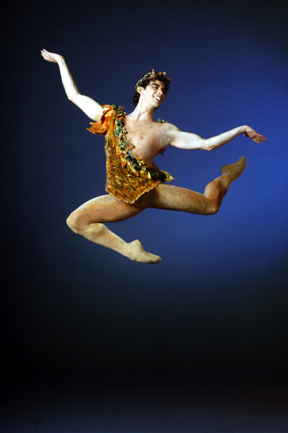American
Ballet Theatre in The Dream. Great Performances; PBS
"A
Tribute to Sir Fred", Asv Living Era Audio CD (February 24, 2004)
ASIN: B0000Y37N8
by
David Vaughan
copyright
© 2004 by David Vaughan



A couple of years ago, ASV/White Line issued a two-CD set called “Tribute to Madam” (as Dame Ninette de Valois was always known in her company), under the auspices of the Birmingham Royal Ballet: performances by the Royal Ballet Sinfonia under Barry Wordsworth of the complete scores of four of her ballets: Checkmate, The Prospect Before Us, The Rake’s Progress, and The Haunted Ballroom. Now Sanctuary Classics/White Line has followed this up with a two-CD “Tribute to Sir Fred,” under similar auspices and with the same orchestra and conductor. The de Valois set was useful in that those complete scores were not previously available. In the Ashton set, three of the four works have been recorded before, whole or in part: The Two Pigeons, Dante Sonata, and Madame Chrysanthème; of the fourth, Harlequin in the Street, only one number was previously available, and that on the marvelous LP of excerpts from various ballets recorded by Robert Irving, of which a CD transfer would be very welcome. My guess is that the recording of The Two Pigeons and Dante Sonata was made for a practical purpose: for Birmingham Royal Ballet to use when it toured a program of those two ballets, sometimes performing in theaters where it was not possible to have an orchestra. (The company will perform this program during this summer’s Lincoln Center Festival, of course with orchestra.) It’s true that John Lanchbery’s adaptation for Ashton of André Messager’s score for Pigeons was previously available only on cassette (there are two CD recordings of the original score), so a CD is worth having.
Dante Sonata has also been issued in a transfer of the old 78 recording made when the ballet was new, by Louis Kentner (who used to play it at Sadler’s Wells) with the Sadler’s Wells Orchestra conducted by Constant Lambert, who arranged Liszt’s Fantasia for piano and orchestra. This recording was also used for performances of the ballet, when the score and parts were lost during the Sadler’s Wells Ballet’s wartime tour of the Netherlands. Interestingly, this recording runs a minute longer than the new one. For present-day performances, a new recording was obviously desirable, but the Kentner/Lambert one can bring back the atmosphere of the old Sadler’ s Wells, and the catharsis one experienced at performances of the ballet in the first year of World War II.
I never saw Madame Chrysanthème, but people who did have said that it was a charming ballet. I have to say that musically Alan Rawsthorne’s score is not distinguished: there aren’t many good tunes, the music is not even very dancey—like a lot of English ballet music of a certain kind, it goes from one pointless climax to another in an attempt to underline the dramatic action. I wouldn’t have thought it was the kind of music that Ashton found inspiring—in fact when he was told that Messager had composed an opérette based on Pierre Loti’s novel, he said he wished he had known, he might have liked the music better. It seems to me that the previously recorded suite of four movements from the ballet, in the series The Composer Conducts, was quite enough. I would rather have here a complete recording of Lambert’s Horoscope (though that score too may have been lost in the Nazi invasion of Holland) or of all the Liszt music for Apparitions, in Gordon Jacob’s wonderful orchestration.
Harlequin in the Street, on the other hand, to a selection of keyboard music by François Couperin, arranged by Lambert and orchestrated by Jacob, is a real find, and pure delight. It was a delicious ballet, originally a short curtain-raiser to a production of Molière’s Le Misanthrope in which Lydia Lopokova played, then expanded for the repertory of the Vic-Wells Ballet. The atmosphere was that of the Italian comedy of Molière’s time (and Watteau’s) rather than the commedia dell’ arte of Goldoni, perfectly recalled in André Derain’s décor and costumes—Harlequin (danced by Alan Carter, still in his teens) was in a workaday suit of green and white stripes rather than the many-colored diamond-shape lozenges of Arlecchino’s costume.
By the way, the enlarged version was first produced at Sadler’s Wells, not the Ambassador’s Theatre, as it says in the liner notes (the Ambassador’s was the theatre to which Le Misanthrope transferred from the Arts Theatre in Cambridge). And Madame Chrysanthème was first performed by the Sadler’s Wells Ballet at the Royal Opera House, Covent Garden, not the Wells.
Photos, all by Marty
Sohl:
First, Ethan Stiefel as Oberon.
Second: Alessandra Ferri as Titania with Julio Bragado-Young as Bottom.
Third: Herman Cornejo as Puck.
Originally
published:
www.danceviewtimes.com
Volume 2, Number 20
June 1, 2004
Copyright © 2004 by David Vaughan
|
|